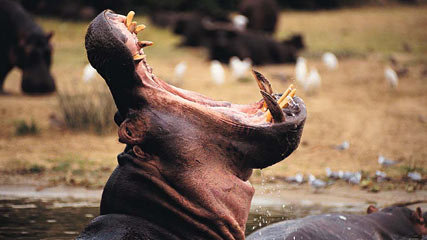
Besides being a powdery biological weapon that grabbed headlines in the perilous week following the Sept. 11, 2001, terror attacks (when some was mailed to Sens. Tom Daschle and Patrick Leahy, among others), anthrax is also a soil-dwelling bacteria -- bacillus anthracis bacterium -- that is clearly harmful to both humans and animals alike. Symptoms of infection can include high fever and bleeding.
The latest strain seems to be contained to the Kazinga channel, a small waterway in Queen Elizabeth National Park in Uganda, according to Nicholas Kauta, commissioner of the Ministry of Agriculture, Animal Industry and Fisheries, who's also in charge of the anthrax problem.
In late July, 82 hippos were reported dead and nine buffalo. Since June, the death toll has climbed to more than 90 animals due to the anthrax strain, officials said.
The first hippo fatalities actually occurred in July 2004 at the Queen Elizabeth park and vexed local officials for several months. As they attempted to discern the cause (anthrax), the death toll mounted to 300. This most recent incident was discovered in June, when 10 hippos died within a 24-hour period.
Park area conservation manager Tom Okello says his staff has learned from the 2004 kills, and they are currently curbing the problem. Back then, task forces were called in to identify anthrax strains and find levels of contamination in the soil and water. Cattle were vaccinated, and people were warned against ingesting hippo meat.
The most recent exposure is reportedly not harmful to the park's human visitors.



I saw a TV programme about this the other day, a zoologist has viewed and now filmed Hippos ingesting the rotting stomach contents of other dead hippo's carcasses even though the hippo is a known herbivore it will not pass up the chance of a free pre digested meal, in the process it is ingesting anthrax infected flesh. Conservationists and game wardens in the area are now removing the bloated rotting carcasses and the outbreak is coming to an end...